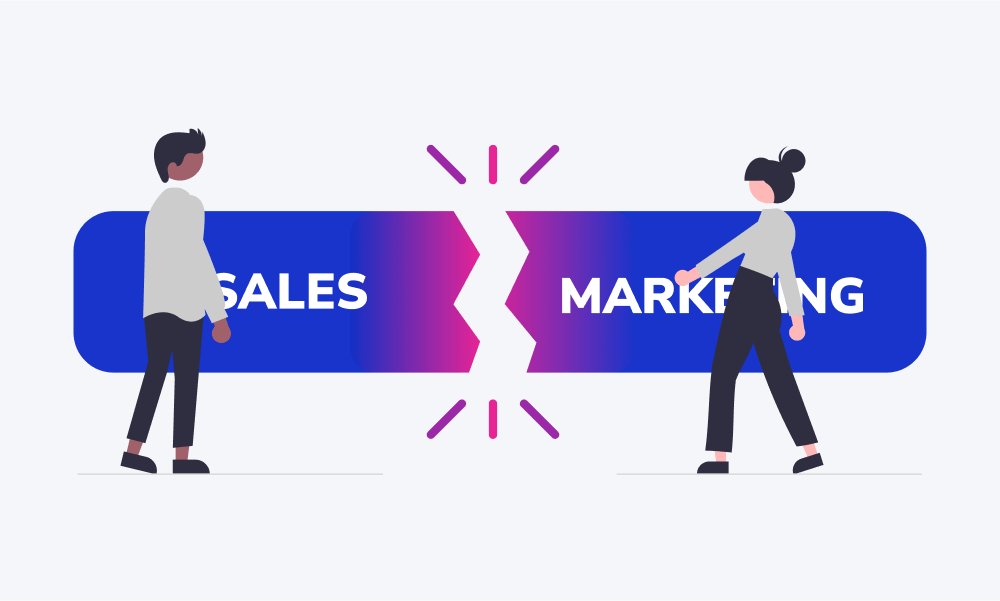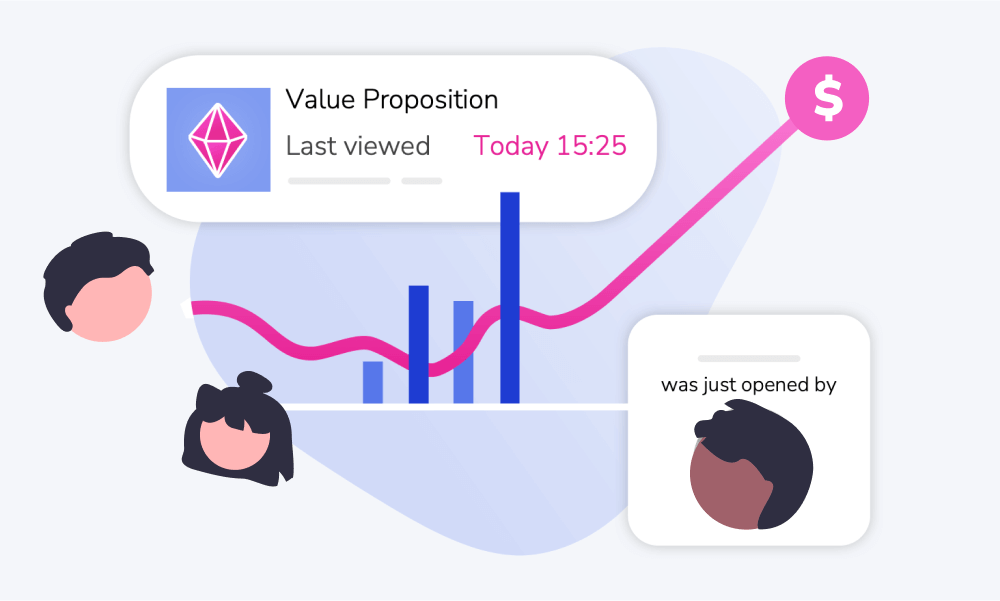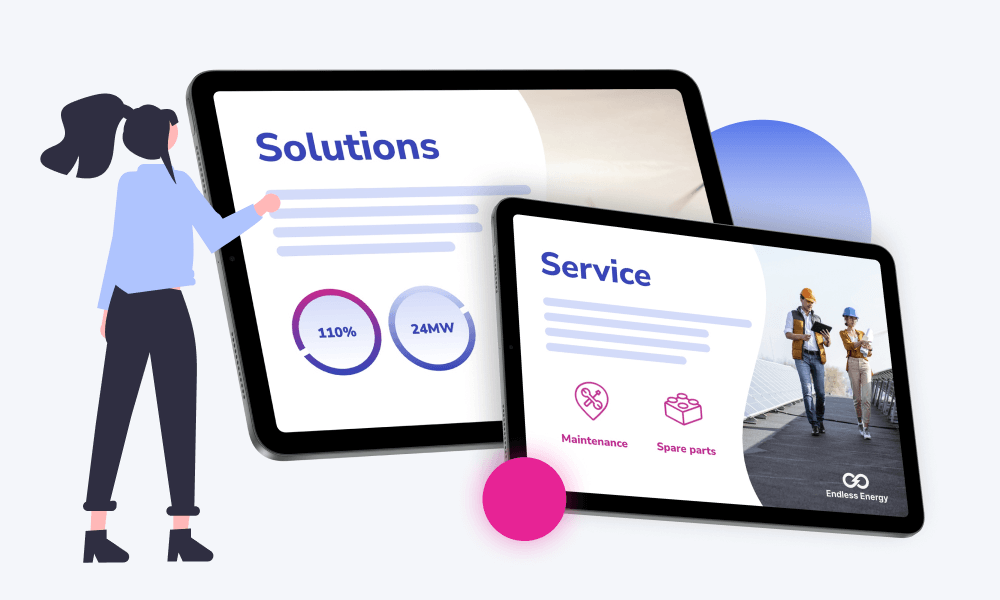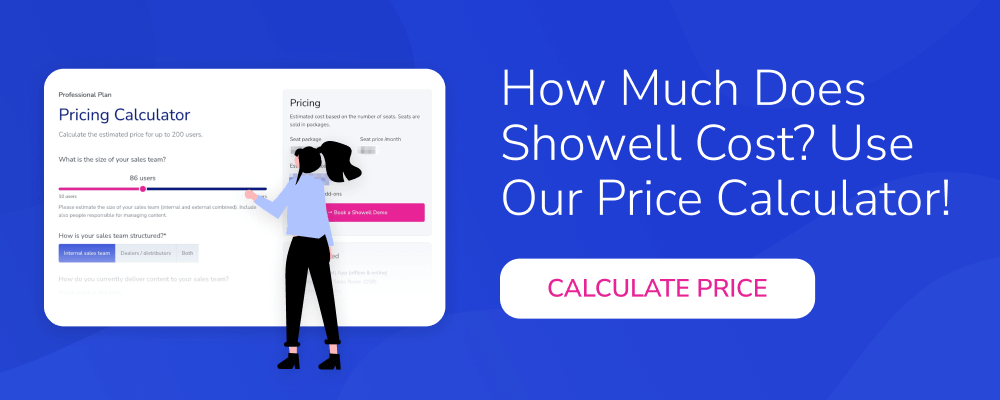In today's competitive business environment, the need to consistently enhance sales performance and improve team productivity is non-negotiable. This is where the concept of 'Sales Enablement' has taken center stage, transforming the way companies approach sales and marketing.
Think of a time when your team had the perfect solution to a client's problem, but didn't have the right resources to communicate it effectively. The chances are that the deal didn't go through, not because of the lack of capability, but because of the absence of enablement.
According to these recent statistics from Qwilr, 87% of companies on the Cloud 100 list have sales enablement or revenue enablement professionals in their organizations.
In this article, we'll take a deep dive into the universe of sales enablement benefits. We'll discuss its significance, the risks of operating without it, its undeniable advantages, and how you can begin your own sales enablement journey.
Table of contents:
Understanding Sales Enablement
Sales enablement might sound like a complex, corporate term, but it's essentially a straightforward concept with far-reaching implications. At its core, sales enablement is the process of providing your sales team with the tools, resources, knowledge, and skills they need to engage effectively with prospects and customers. It's about empowering your sales team to sell at a higher velocity and bring in greater revenue.
Historically, the role of a salesperson was relatively simple; they were expected to sell a product or service using their persuasive skills and charisma. However, the advent of digital technology, the internet, and the evolved buying behavior of customers have completely reshaped the sales landscape.
Today's buyers are more informed and have higher expectations. They desire a customized, consultative approach rather than a one-size-fits-all sales pitch. This necessitates a shift in the way sales teams operate, making sales enablement a critical component of a successful sales strategy.
To bring this idea to life, let's consider an example. Suppose you run a SaaS company that offers a highly technical and complex product. Your sales team is composed of highly motivated individuals, but they lack a deep understanding of the product and the best way to position it to various customer segments. The result? Lost opportunities and low sales figures.
But, when you introduce sales enablement into this equation, you equip your team with in-depth product knowledge, teach them how to communicate the product's value to different customer personas, provide them with compelling sales collateral, and implement a streamlined sales process. Now, your salespeople are not just sellers; they're consultants who understand the customer's needs and can articulate how your product is the best solution.
So, sales enablement is not just a concept, it's a catalyst that can drive your sales performance to new heights.
In the following sections, we'll explore the risks of neglecting sales enablement and delve into the concrete benefits it brings to your business.
6 Common Pitfalls and Inefficiencies without Sales Enablement
Operating without sales enablement in today's business environment is like embarking on a long journey without a map - you might eventually reach your destination, but the path will be riddled with unnecessary difficulties and detours. The sales landscape has become increasingly complex and competitive, and businesses that fail to adapt to these changes risk falling behind.
A lack of sales enablement can manifest in various ways, leading to a myriad of challenges that can hinder your business's growth and profitability. Let's explore some of these potential pitfalls and their implications.
1) Misalignment Between Sales and Marketing Teams
According to a study by Forrester, organizations with tightly aligned sales and marketing operations achieve 24% faster growth and 27% faster profit growth over a three-year period.
Sales and marketing are two sides of the same coin, yet without a unifying structure, they often operate in silos. Without a solid sales enablement strategy, your sales and marketing teams can become misaligned.

They may work in silos, with little to no collaboration or understanding of each other's roles, responsibilities, and challenges. This can result in duplicated efforts, missed opportunities, and a disjointed customer experience.
For instance, marketing might be creating content that the sales team finds irrelevant or difficult to use, or the sales team might not be effectively communicating customer feedback to the marketing team. This disconnect can lead to wasted resources, missed opportunities, and a disjointed customer experience.
2) Inconsistent Branding and Messaging
One of the often-overlooked aspects of sales enablement is its role in ensuring consistency in branding and messaging. As your business grows and your sales team expands, maintaining a unified brand voice and message can become increasingly challenging. This can lead to inconsistencies, which can confuse your prospects and dilute your brand's impact.
Moreover, inconsistent branding goes beyond just messaging. It also encompasses visual elements like logos, color schemes, typefaces, and the overall aesthetic of your sales collateral. According to research by Lucidpress, consistent brand presentation across all platforms can increase revenue by up to 23%.
3) Lower Sales Productivity and Effectiveness
In the absence of a comprehensive sales enablement strategy, businesses often experience a decrease in sales productivity and effectiveness. Why? Because without the right tools, resources, and insights at their disposal, salespeople can end up spending a significant chunk of their time on non-selling activities.
To put things into perspective, imagine a salesperson who spends hours searching for the right content to share with a prospect, or manually entering data into a CRM system, or trying to figure out a convoluted sales process. All these activities eat into the time they could spend on actually selling, and can consequently lead to lost opportunities and reduced sales performance.
On average, salespeople spend just 34% of their time selling. This means that the majority of their time is spent on administrative tasks or looking for the right resources – a clear sign of inefficient use of their skills and time.
In addition to lost time, without sales enablement, your sales team may not be equipped with the most effective selling strategies and tactics, or be kept abreast of evolving customer needs and market trends. This can result in less effective sales pitches, lower conversion rates, and ultimately a decrease in revenue.
4) Lack of Access to Relevant Sales Content

In the sales world, content is king. But it's not just about having content; it's about having the right content at the right time.
Sales enablement ensures your sales team has immediate access to the most effective, relevant, and updated content tailored to each stage of the buyer's journey. However, without a proper sales enablement strategy, your sales team may struggle to find or even create the most relevant sales content, leading to inefficient sales processes and missed opportunities.
❓Let's consider a scenario. A sales representative has managed to secure a meeting with a potential client. During the meeting, the client asks some specific questions about the product's features or requests a case study relevant to their industry. If the sales representative can't readily provide this information or material, the momentum of the sales conversation may falter, and the opportunity could be lost.
✅ Now, imagine the same scenario, but the sales representative, backed by a robust sales enablement platform, immediately pulls up the requested information or case study, thereby sustaining the momentum and possibly even closing the deal.
This is the power of having the right content at your fingertips. But, according to a report by Forrester, 65% of content created by marketing for sales is never used. This underutilization of content is often due to the lack of a proper sales enablement strategy, leading to sales reps either not being aware of existing content or not having easy access to it when they need it the most.
Having a sales enablement strategy in place not only ensures your sales team has quick access to relevant sales content, but it also ensures that this content is consistently updated and improved based on feedback and performance metrics.
5) Limited Visibility into Sales Performance and Analytics
In the modern sales landscape, data is a game-changer. It not only provides insight into past performance but also guides future strategy and decision-making.
Take, for instance, a sales team that operates without a defined sales enablement process. They might be making sales, but without tracking key metrics and analytics, it's challenging to understand what's driving those sales. Are certain products more popular than others? Are specific sales reps outperforming their peers, and if so, why? Without visibility into these factors, it becomes difficult to replicate success, identify areas of improvement, or strategize effectively for future growth.
Moreover, when sales data is not effectively tracked and analyzed, it's challenging to align sales efforts with broader business goals. For example, without the use of content analytics, your sales people may have a more difficult time to reach out to the prospect at the right moment with resonant content. Your sales strategy becomes a shot in the dark rather than a calculated move.
According to a study by McKinsey, organizations that leverage sales analytics see a 5-10% increase in their sales productivity. Furthermore, Aberdeen found that businesses using sales analytics are 1.4 times more likely to hit their sales targets.

By integrating a sales enablement strategy into your operations, you're not just empowering your sales team with resources and content, but also equipping your business with powerful analytics to track, measure, and improve sales performance. Sales enablement platforms often come with inbuilt analytic tools, which provide real-time insights into your sales performance and offer actionable feedback to help your team improve.
See how your content engages with your prospects with Showell Sales Content Analytics →
6) Inefficient Sales Training and Onboarding
Without proper sales enablement, training, and onboarding new sales hires becomes a haphazard process, resulting in inconsistencies in knowledge, skills, and sales techniques. Salespeople may lack the necessary guidance and resources to understand your products or services thoroughly, resulting in missed opportunities and lost deals.
According to Sales Enablement Pro, an effective implementation of sales enablement in onboarding and training decreases a sales rep’s ramp time decreases by 26%. By incorporating sales enablement into your onboarding and training programs, you can provide standardized training materials, product knowledge resources, and access to best practices.
This ensures that new hires are equipped with the necessary skills and information to represent your brand effectively, leading to faster ramp-up times and increased sales productivity.
In our blog Fixing Sales Performance Issues: A Guide to Sales Process Optimization, we expand a bit more on the common issues in sales performance and what causes those to occur. On top of that, we also uncover sales metrics you can use to measure sales performance more efficiently and steps to optimize your sales process.
In the next section, we will explore how a dedicated sales enablement strategy can help your organization overcome these challenges and reap substantial benefits, ultimately leading to improved sales performance and revenue growth.
4 Main Benefits of Sales Enablement for Your Business
With a solid understanding of the pitfalls of operating without sales enablement, it's essential to explore the transformative benefits it can bring to your organization. A well-executed sales enablement strategy can serve as a catalyst for your business's success, offering numerous benefits that can directly impact your bottom line. Here are some key benefits of implementing sales enablement and how leveraging a platform like Showell can help you.
1) Enhanced Sales Content Management and Distribution
Sales enablement platforms allow you to centralize your sales content, making it easily accessible to your sales team at any time, from anywhere. According to G2, sales reps spend 440 hours per year, the equivalent of nearly 11 weeks, searching for the right content. By eliminating the need for time-consuming content searches.
One of the critical aspects of sales enablement is effective sales content management. Let’s look at the following aspects:
- Centralized Repository for Sales Collateral
With a sales enablement platform, all the marketing and sales collateral is stored in a single, easily accessible place. Sales enablement apps even allow for offline access enabling your sales team to have unbounded access to sales collateral wherever they are, whenever they need it. - Personalized Content for Different Buyers
An efficient sales enablement platform enables you to customize content for various buyers. Tools like a Digital Sales Room let your salespeople pitch to their customers in a branded digital environment, with content only relevant and resonant to them.
- Version Control and Content Governance
This ensures everyone in your sales team is using the most recent, approved version of your collateral, reducing inconsistencies. No more having to track down other versions of your content and having to update every single one. - Efficient Distribution of Sales Content
In addition to managing your sales collateral all in one place, a robust sales enablement tool also simplifies distribution. Your buyers can quickly mix and match content to suit their needs, and you can easily share it with them with a link to a Digital Sales Room. Regardless of the file format, all relevant content is now housed in one location, making it easier for your prospects.
Learn more about: All You Need To Know About Sales Content Management →
2) Robust Sales Enablement Analytics
As we've noted, one of the most significant advantages of a sales enablement platforms is the ability to provide robust analytics that go beyond just tracking sales figures. But what does this mean in practical terms, and how can it transform your sales operations?
Imagine you have a wealth of sales content - product brochures, case studies, presentations, and more. How do you know which of these materials are truly making an impact and resonating with your prospects? How do you determine which resources are instrumental in closing deals? Without a platform like Showell, this becomes a game of guesswork.
With advanced analytics capabilities, you can track how each piece of your sales content is performing. You can see what content your sales reps use the most, what materials they share with prospects, and even how prospects engage with the content. Do they spend time reading through the entire case study, or do they lose interest halfway? Do they revisit the product brochure multiple times, indicating a high level of interest?
This level of granularity allows you to make data-driven decisions about your content strategy. For instance, if a particular case study seems to resonate exceptionally well with prospects, you may choose to create more case studies focusing on similar formats, themes or industry verticals.

Additionally, sales enablement analytics can provide insights into your sales reps' performance. You can identify top-performing reps and understand what they're doing differently. Perhaps they're using a unique mix of sales content, or maybe their follow-up strategy is more effective. These insights can be shared across the team to elevate everyone's performance.
A study by McKinsey shows that organizations that leverage sales analytics witness a 5-10% increase in sales productivity.
Read more about The What, Who, Why and How of Sales Content Analytics →
3) Enhanced Sales Training and Onboarding
One of the critical areas where sales enablement, makes a significant difference is in the onboarding and training of sales representatives. Let's delve into how sales enablement streamlines this process.
- Standardized Onboarding Processes
Without a sales enablement platform, onboarding new sales reps can be a cumbersome process. Each new hire may receive different training depending on who is available to train them, leading to inconsistencies in knowledge and skills across your team.
Sales enablement platforms ensure a standardized onboarding process for all new hires. You can create a systematic onboarding program, which can be easily accessed by new reps. This ensures every member of your sales team receives the same level of training and information, leading to consistency in skills and knowledge. - Access to Training Materials and Resources
Sales enablement platforms provides a centralized repository for all your training materials. This means that new reps can access training resources, such as product information, sales techniques, or industry insights, at any time. This immediate access speeds up the learning process and allows new reps to become productive much faster.
In addition, with the ability to update materials in real-time, you can ensure your team is always armed with the most current information. This is particularly crucial in industries where product features or market dynamics can change rapidly. - Continuous Learning and Development Opportunities
Learning in sales doesn't stop after the initial onboarding! Market trends evolve, buyer behavior changes, and new product features are introduced. With sales enablement platform, your sales reps have continuous access to updated content and resources, enabling them to learn and adapt in real-time. This creates a culture of continuous learning and development, which is crucial for long-term sales success.
Moreover, sales enablement analytics can help you identify areas where a rep might need further training. For example, if a rep is struggling to close deals, you can analyze their sales activity and identify areas of improvement. This targeted training approach can dramatically improve a rep's performance.
| 👉 A successful sales onboarding can be the key differentiator for team's overall success. Learn more about it from our blog Mastering Sales Onboarding: The Key to Success in B2B Sales. |
4) Instilling Confidence and Preparedness in Salespeople
Confidence is a critical component of a successful salesperson's arsenal. The more equipped and prepared a salesperson is, the more confidently they can approach their prospects. A well-prepared salesperson can answer queries, address objections, and provide the right information at the right time, thereby nurturing and moving the prospect along the sales funnel.
With a sales enablement platform, your salespeople have immediate access to a wealth of information at their fingertips. Be it product specifications, case studies, competitor analyses, or customer testimonials; everything is readily available in a user-friendly interface. No longer do they need to scramble when a prospect shows sales resistance or promise to get back to the customer later, thereby disrupting the flow of a sales conversation.
Moreover, sales enablement tools also provide visibility into what content works best at different stages of the sales cycle. So, sales reps know exactly what materials to use to address a prospect's specific needs or challenges. This eliminates guesswork and enables sales reps to tailor their sales approach effectively.
|
Struggling with long sales cycles, insufficient sales training, inconsistent messaging, a lack of performance visibility, or inefficient processes? Sales enablement can help. |
6 Steps to Start Your Sales Enablement Journey
Embarking on your sales enablement journey may seem daunting, especially considering the wealth of strategies, tools, and technologies available. However, by breaking down the process into manageable steps, you can ensure a smooth transition. Here's a step-by-step guide to kickstart your sales enablement initiative with a focus on integrating a tool like Showell.
1) Define your goals and objectives
Every successful journey begins with a clear destination in mind. What do you want to achieve through sales enablement? Is it to shorten the sales cycle, improve sales productivity, or maybe to standardize the onboarding process? Setting clear, measurable objectives is key. Defining SMART sales enablement goals ensures your strategy stays focused and results-driven. By defining your goals, you set a direction for your sales enablement initiative.
2) Identify your needs
Assess your current sales process to identify gaps and areas of improvement. Are your sales reps spending too much time searching for content? Do they struggle to keep up with product updates? These insights will help you determine what features you need in a sales enablement tool.
3) Choose a sales enablement tool
Once you've defined your goals and identified your needs, you can start evaluating sales enablement tools. Look for a tool like Showell, which offers a comprehensive suite of features, including content management, analytics, and training resources.
4) Implement the tool
With Showell, implementation is a breeze. The platform offers a user-friendly interface and seamless integration with existing systems, minimizing disruption to your sales operations. Moreover, Showell's team provides comprehensive training and support to ensure a smooth transition.
5) Train your team
Once the tool is implemented, it's crucial to train your sales team to use it effectively.
6) Monitor, evaluate, and optimize
After implementation and training, monitor your sales enablement initiative's progress towards achieving your goals. Sophisticated analytics provide visibility into your strategy's effectiveness, helping you identify areas of improvement and optimize your approach.
Starting your sales enablement journey is an investment in your organization's future. The next step is to take the plunge and experience the transformative power of sales enablement for yourself.
All in all…
The journey of sales enablement is one filled with opportunities for growth, efficiency, and success. Through this exploration, we've defined what sales enablement is and shone a light on the significant risks you might be facing without it, from misalignment between sales and marketing teams to limited visibility into sales performance.
We've also underscored the concrete benefits that sales enablement can offer your organization, including streamlined content management, robust sales analytics, efficient onboarding, and instilling a sense of confidence and preparedness in your salespeople. The positive impact on your sales cycle and revenue generation potential cannot be overstated.
In a world where every sales interaction counts, sales enablement is no longer a luxury; it's a necessity. Empower your sales team with the right information at the right time, equip them with a tool that increases their efficiency, and you'll soon realize that sales enablement is not just a buzzword—it's a strategy for success.
Learn next:
-
More about Sales Enablement
-
7 Essential Skills Your Team Needs to Achieve Sales Enablement Goals
- Buyer’s Guide: How To Choose the Right Mobile Sales Enablement App





